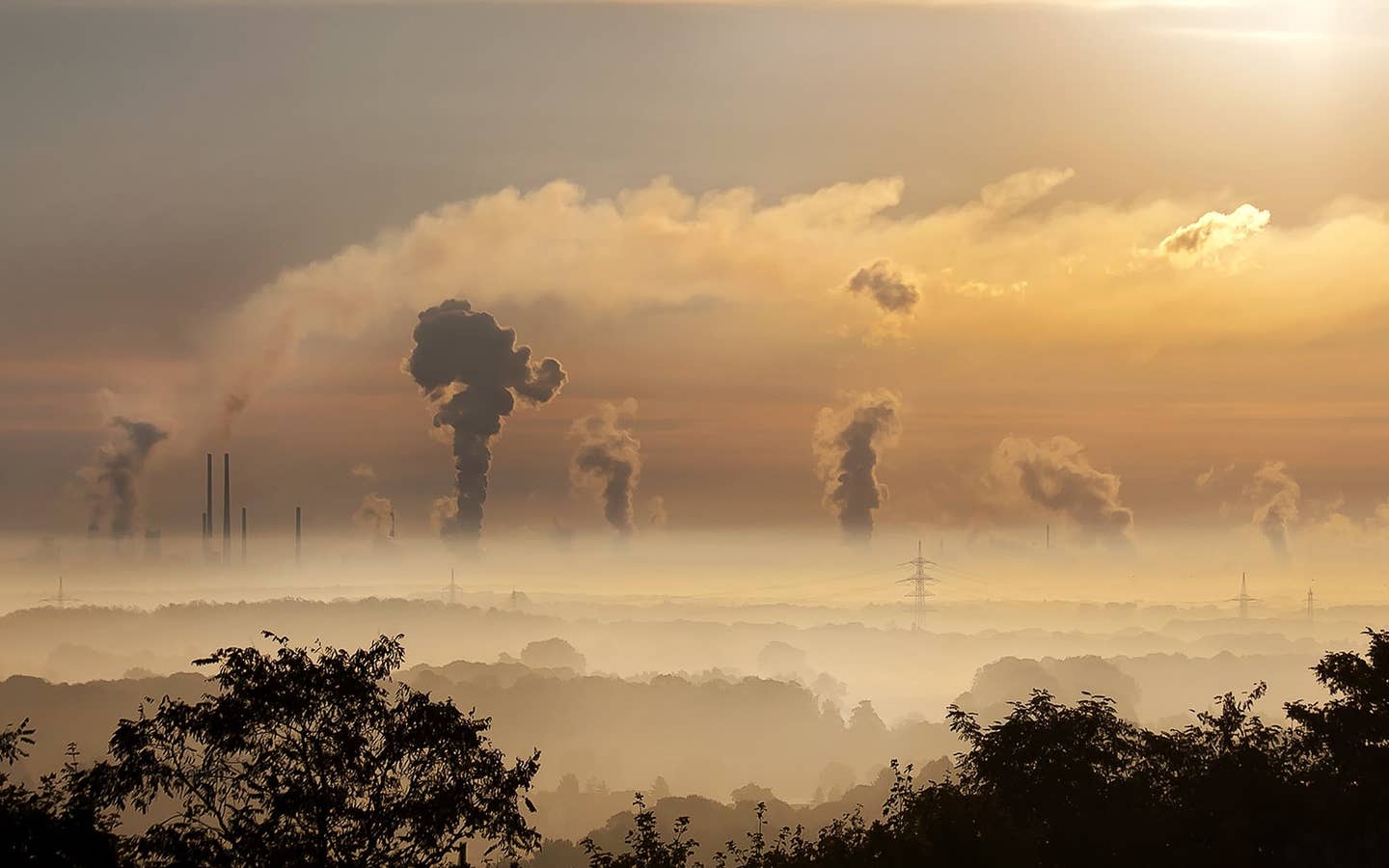Groundbreaking study reveals the unexpected cause of ozone pollution
Discover how winter ozone pollution challenges air quality norms, with insights from Lanzhou’s petrochemical-driven smog crisis.

Winter ozone pollution in industrial cities like Lanzhou reveals surprising chemical mechanisms and urgent solutions for year-round air quality management. (CREDIT: CC BY-SA 4.0)
Ozone pollution, typically associated with warm weather and strong sunlight, has begun to manifest alarmingly in winter. This surprising phenomenon has surfaced in several regions, most notably Lanzhou, a petrochemical hub in northwestern China. High levels of ozone pollution during cold months challenge established understandings of air quality dynamics and pose new threats to public health and the environment.
For decades, ozone pollution has been linked to summer’s intense sunlight and heat, which drive chemical reactions between ozone precursors such as nitrogen oxides (NOx), volatile organic compounds (VOCs), and carbon monoxide (CO).
These reactions are bolstered by high temperatures and strong solar radiation. Yet, recent winters in northern China have recorded alarming ozone levels, with Lanzhou—a city renowned for its industrial activity—showcasing this phenomenon most strikingly.
In January 2018, hourly ozone concentrations in Lanzhou exceeded 100 parts per billion by volume (ppbv), peaking at 121 ppbv. This far surpasses the safety threshold and highlights an urgent need to understand the underlying causes. Researchers attribute this anomaly to unique atmospheric conditions and local industrial emissions, primarily from the petrochemical sector.
The discovery of such high ozone levels during winter underscores a broader trend. Similar pollution events have been documented in other regions, such as the Yellow River Delta and Shijiazhuang, where heavy industrial emissions and specific meteorological conditions create conducive environments for wintertime ozone formation.
These findings, published in the journal, Environmental Science and Ecotechnology, highlight the need for reevaluating air quality management strategies traditionally focused on summer months.
The primary culprits behind Lanzhou’s winter ozone pollution are alkenes, reactive hydrocarbons released during petrochemical processes. During the 2018 study period, daytime concentrations of total non-methane VOCs averaged 153.4 ppbv, with alkenes accounting for more than half.
Surprisingly, the typical drivers of ozone formation—sunlight and warmth—played minimal roles. Instead, chemical reactions involving alkenes—particularly their ozonolysis—emerged as the dominant mechanism.
Ozonolysis of alkenes produces Criegee intermediates, unstable molecules that rapidly decompose into reactive radicals (OH, HO₂, and RO₂). These radicals fuel a chain reaction that accelerates ozone production, even under weak sunlight and low temperatures.
In Lanzhou, alkene ozonolysis contributed nearly 90% of the ozone generated during the pollution episodes. This unique mechanism underscores the significance of localized emissions and challenges conventional wisdom that associates ozone formation exclusively with sunny, hot weather.
Related Stories
The specific alkenes driving this phenomenon include trans/cis-2-butene and propene, which are emitted in large quantities from Lanzhou’s petrochemical industry. These reactive hydrocarbons not only dominate the local chemical processes but also highlight the need for targeted emission controls in industrial regions.
Lanzhou’s geography amplifies its pollution woes. Situated in a basin surrounded by mountains, the city experiences poor air circulation. This natural barrier traps pollutants, creating conditions that exacerbate wintertime air quality issues. The dense emissions from the city’s petrochemical facilities further compound the problem.
Historically, ozone studies in Lanzhou have focused on summer, when high temperatures and sunlight dominate. However, the 2018 winter study revealed that weak solar radiation (averaging 263.6 watts per square meter) and low temperatures (–1.7°C) did not hinder ozone formation. Instead, these conditions, combined with high precursor emissions, led to severe pollution.
Moreover, the city’s reliance on heavy industry, coupled with increased energy demand during winter, contributes to elevated emissions of NOx and VOCs. These pollutants, under stagnant weather conditions, accumulate in the lower atmosphere, creating a perfect storm for ozone formation.
The findings from Lanzhou offer actionable insights for combating wintertime ozone pollution. Reducing alkene emissions by 28.6% or NOx levels by 27.7% during early afternoon hours could significantly lower ozone concentrations. These targeted strategies are critical for regions reliant on petrochemical industries.
"This study updates how we understand ozone pollution, proving that intense formation can occur in cold, low-light conditions," stated researchers Jin Yang and Yangzong Zeren. "Our findings complement conventional views and call for targeted action in industrial regions."
Advanced modeling played a pivotal role in these discoveries. Using a photochemical box model coupled with the Master Chemical Mechanism (PBM-MCM), researchers simulated ozone formation under Lanzhou’s unique conditions. This approach provided valuable insights into the chemical pathways and highlighted the role of Criegee intermediates in winter ozone production.
The implications extend beyond Lanzhou. Similar pollution patterns have been observed in other regions with heavy industrial activities, such as the Yellow River Delta and North China Plain. These findings emphasize the need for global attention to wintertime ozone pollution, particularly in industrial hubs.
The rise of wintertime ozone pollution underscores the complexity of air quality management. Traditional mitigation strategies often focus on reducing summer ozone levels, driven by assumptions about photochemical reactions. However, the Lanzhou study highlights the necessity of year-round monitoring and tailored interventions.
Industries must adopt cleaner technologies and reduce emissions of reactive hydrocarbons like alkenes. Policymakers should implement stricter regulations and promote research into alternative fuels and emission control technologies. Public awareness campaigns can also play a role in reducing pollution by encouraging responsible energy consumption and transportation practices.
The findings from Lanzhou also call for greater international collaboration. As industrial activities grow and climate conditions shift, understanding the nuances of ozone formation becomes increasingly critical. Joint research initiatives can help identify global hotspots of winter ozone pollution and develop effective mitigation strategies.
Wintertime ozone pollution is a stark reminder of the evolving challenges in environmental science. While summer smog remains a significant concern, the emergence of cold-weather ozone highlights the need for comprehensive, year-round solutions.
The lessons from Lanzhou provide a roadmap for addressing these challenges and ensuring cleaner, healthier air for all.
Note: Materials provided above by The Brighter Side of News. Content may be edited for style and length.
Like these kind of feel good stories? Get The Brighter Side of News' newsletter.
Joshua Shavit
Science & Technology Writer | AI and Robotics Reporter
Joshua Shavit is a Los Angeles-based science and technology writer with a passion for exploring the breakthroughs shaping the future. As a contributor to The Brighter Side of News, he focuses on positive and transformative advancements in AI, technology, physics, engineering, robotics and space science. Joshua is currently working towards a Bachelor of Science in Business Administration at the University of California, Berkeley. He combines his academic background with a talent for storytelling, making complex scientific discoveries engaging and accessible. His work highlights the innovators behind the ideas, bringing readers closer to the people driving progress.



